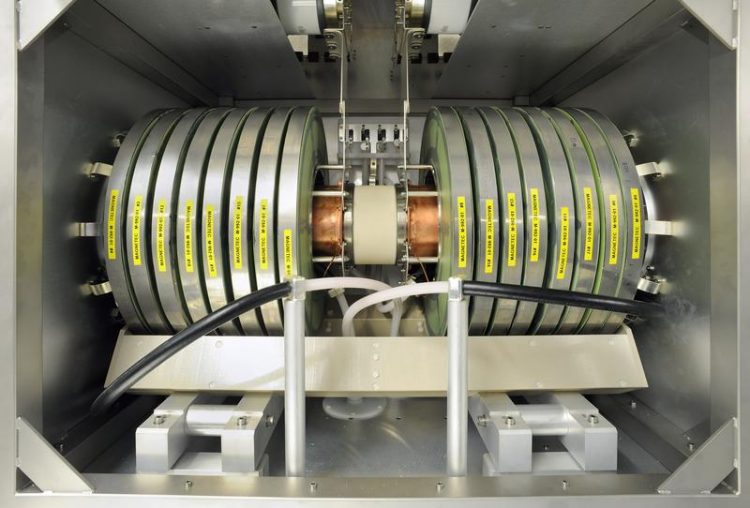First component delivered for FAIR’s ring accelerator

View into the interior of the bunch compressor. G. Otto, GSI Helmholtzzentrum für Schwerionenforschung
“FAIR’s ring accelerator will be composed of many different components that we design, develop, and plan in detail with the help of complex calculations and design studies,” says GSI project area manager Peter Spiller, who is responsible, among other things, for the construction of the ring accelerator at FAIR. “The fact that the delivery of the components has now begun is a real milestone for us. We expect to receive several additional components this year.”
“We’re delighted that the development and production of the bunch compressors has enabled our small Hessian company to make a major contribution to FAIR, a globally significant high-tech project,” says Joachim Scherer, Managing Director of Aurion Anlagentechnik GmbH in Seligenstadt.
FAIR’s ring accelerator will be able to accelerate ions (electrically charged atoms) from any element as well as antiprotons to almost the speed of light. Before particles are accelerated, they first have to be packed into bunches that consist of up to 500 billion ions each. The particles are then channeled to the various experiments. The size of the ion bunches depends on the experiment they are used for. The bunch compressor can generate especially short pulses that are needed for experiments in plasma physics and nuclear astrophysics, for example.
“The bunches have a temporal length of 200 to 300 nanoseconds during acceleration. This is too long for some experiments, which require the large number of ions in a shorter period of time,” says Spiller. “The bunch compressor system shortens the ion bunches to a duration of 30 to 90 nanoseconds. To do this, we use high-frequency electric fields that compress the ion pulse by rotating it in the phase space.”
“The bunch compressor is 2 meters long and 1.20 meters wide. It is 2.10 meters tall and weighs around two tons. The key structural elements are two sets of eight disks composed of special magnetic alloys that are arranged around the beamline. These disks can generate a high-frequency voltage of 40,000 volt,” says high-frequency physicist Hans Günter König from GSI’s Ring RF department.
König and his colleague Peter Hülsmann were the main people in charge of implementing the project technology and liaising with the manufacturer. “In the next step, the device will be subjected to extensive testing that will be conducted on the test rig for high-frequency systems at GSI. These tests are scheduled to be completed this spring. Series production will begin as soon as the bunch compressor has passed all of the tests.”
FAIR will be one of the largest and most complex accelerator facilities in the world. The existing GSI accelerator facility will be part of FAIR and serve as first acceleration stage. For FAIR engineers and scientists will expedite technological developments in many areas in international cooperation, for example in computer science or in superconductivity techniques. Approximately 3,000 scientists from all over the world will conduct cutting-edge research at FAIR. In unique experiments they will gain new basic insights into the structure of matter and the evolution of the universe.
https://www.gsi.de/en/start/news/detailseite/2016/03/08/first-component-delivere…
Media Contact
All latest news from the category: Physics and Astronomy
This area deals with the fundamental laws and building blocks of nature and how they interact, the properties and the behavior of matter, and research into space and time and their structures.
innovations-report provides in-depth reports and articles on subjects such as astrophysics, laser technologies, nuclear, quantum, particle and solid-state physics, nanotechnologies, planetary research and findings (Mars, Venus) and developments related to the Hubble Telescope.
Newest articles

Superradiant atoms could push the boundaries of how precisely time can be measured
Superradiant atoms can help us measure time more precisely than ever. In a new study, researchers from the University of Copenhagen present a new method for measuring the time interval,…

Ion thermoelectric conversion devices for near room temperature
The electrode sheet of the thermoelectric device consists of ionic hydrogel, which is sandwiched between the electrodes to form, and the Prussian blue on the electrode undergoes a redox reaction…

Zap Energy achieves 37-million-degree temperatures in a compact device
New publication reports record electron temperatures for a small-scale, sheared-flow-stabilized Z-pinch fusion device. In the nine decades since humans first produced fusion reactions, only a few fusion technologies have demonstrated…





















